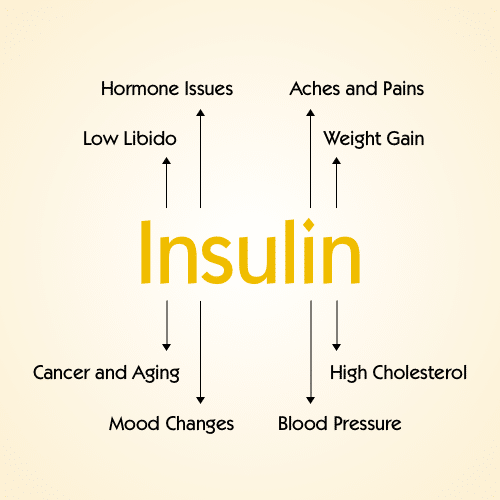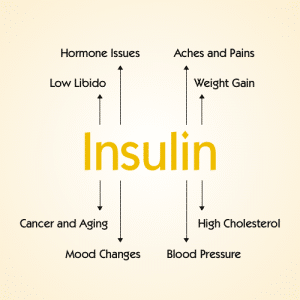
 A couple weeks ago in the first part of this series, I wanted to achieve two goals. First, to help people with insulin resistance or type II diabetes understand what “insulin resistance” really is. Second, I wanted to let people know they don’t have to continue to take prescription medications the rest of their lives.
A couple weeks ago in the first part of this series, I wanted to achieve two goals. First, to help people with insulin resistance or type II diabetes understand what “insulin resistance” really is. Second, I wanted to let people know they don’t have to continue to take prescription medications the rest of their lives.
Diabetes can be reversed. Medication may have been presented as the only option, but it wasn’t and isn’t the only choice. I also talked about sending the right signals to our “’cellular brains” (the nucleus) in order to reverse insulin resistance and diabetes. Our goal today will be to explain what signals we need to send in order for that to happen.
One disclaimer here is that some medications have low blood sugar as a side effect, and that engaging in the process of diabetes reversal may increase that risk. The following information is for informational purposes only. All individuals should speak with their prescribing physician about tapering off medications or see a physician who specializes in diabetes reversal to ensure utmost safety.
First, let me say that this information can get detailed and complex, so I’m hitting the high points here. This blog-style article is meant to be food for thought, not a comprehensive guide. With that said there are a number of important points I believe need to be made. The keys to reversing diabetes are specific to each individual and there are no one-size-fits-all methods due to our unique and varied biochemistry and genetics.
There are a number of influences that affect not only risk for developing insulin resistance but also ability to reverse it. I’ve said before that what causes something isn’t always exactly what reverses it. That’s actually good news. A lifetime of genetic risk combined with 20 years of putting gas on the fire with poor diet would be a tremendous task to overcome if that were the case.
Let me say here that when I say a “lifetime of poor diet,” I’m not intentionally picking on anyone. The current typical American diet is generally low in nutrients, highly processed, and high in sugar and starch. With that said, here are a few of the right and wrong signals to send.
Get off the bad carbs!
It’s well known by now that the processing of foods into simple, readily broken-down sugar sources causes spikes in blood sugar that send the wrong signals to our cells and tissues. The processing of corn and grains essentially turns them them into super starches and simple sugars. This is achieved by taking out fiber and protein matrix. Our digestive system rapidly absorbs these as they turn into glucose and enter our blood stream unabated. This constant challenging of our system sends the wrong signals and leads to insulin resistance and diabetes.
Improve pH balance
The standard American diet is essentially a net-acidic diet. Our bodies are intricately designed with multiple mechanisms to balance pH, or the amount of acidity in our blood. This happens through our kidneys, respirations, GI tract, and cells and tissues. Nevertheless, the constant barrage of acidic-leaning foods challenges the system and utilizes energy resources. Anything that decreases the amount of available energy decreases metabolism, which again sends the wrong signals.
Don’t miss meals!
If you are trying to reverse diabetes and you skip meals, the stress response kicks in, and you’ll notice your blood sugars are actually higher. This also happens in patients with diabetes when they check their blood sugar in the morning. It’s often higher even though they haven’t eaten! This can be maddening for someone trying to reverse diabetes. The key is to understand why this happens. In someone who already has a high fasting insulin due to insulin resistance, if they do not eat, the insulin overshoots and can cause blood sugar to drop while you sleep. The stress response kicks in and cortisol is released, which mobilizes stored glycogen for rapid breakdown into sugar. The key is to not get too low or too high.
Slowin’ down?
One thing is clear—as we age our energy declines. As our energy declines, we often slow down, become less active, do less exercise, engage in more sedentary activities, etc. As we become less active, the mechanisms involved in stimulating energy production down regulate (there’s that term again!). Over time, metabolism slows, evermore increasing risk for weight gain. Some respond to the lower energy by eating more starchy foods or sugary drinks as a quick fix for low energy. If we succumb to the declining energy with declining activity and increasing sugar, we are clearly sending the wrong signals and accelerating the risk for insulin resistance.
Hormones in the toilet?
Hormones like testosterone, growth hormone, DHEA, and others have a clear role in maintenance of lean muscle, energy production, cognitive function, sex drive, and metabolic rate, among others. Their age-related decline (beginning at around age 30 for most) is also associated with an increased risk for the development of insulin resistance. That doesn’t mean that you necessarily need to be on hormone replacement. In many cases, other reasons could be contributing to hormonal decline. While it happens as we age, the acceleration of that decline is often coupled with stress, lack of restorative sleep, lack of exercise, or even sleep apnea. At the very least, you (and your physician) should be aware of their influence and have them periodically checked.
Don’t stress!
The stress response really can wreak havoc on your system. That source of stress can be physiologic or environmental. For example, if you have a white-knuckle drive to work every day that leads to spikes in stress hormones, that’s not necessarily going to help you reverse insulin resistance. The hormone cortisol not only mobilizes stored forms of sugar, but also increases the production of sugar anew from other sources like protein (i.e. muscle). So stress can be a double whammy by breaking down metabolic machinery (muscle) and increasing blood sugar, both a no-no for diabetes reversal!
Key steps from here:
Have a fasting insulin blood test and find out if you have insulin resistance.
Partner with a team that has experience helping people reverse insulin resistance and/or diabetes to help guide you on your journey.
Enjoy the journey! It doesn’t have to be a fearful and miserable experience. In most cases, as momentum increases, that fear of failure transmits into more energy, more focus, and most important of all… results!
